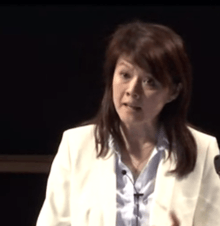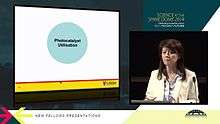Rose Amal
| Prof. Rose Amal FAA FTSE FIChemE FIEAust | |
|---|---|
 June 2014 | |
| Born | Medan, Indonesia |
| Title | Scientia Professor, ARC Laureate Fellow |
| Website |
www |
| Academic background | |
| Alma mater | UNSW |
| Thesis title | Fractal structure and kinetics of aggregating colloidal hematite (1991) |
| Academic work | |
| Discipline | Chemical Engineering |
| Sub discipline | Nanoparticles and catalysis research |
Rose Amal is an Indonesian-born chemical engineer, currently serving as Scientia Professor and ARC Laureate Fellow in the School of Chemical Engineering at the University of New South Wales, Australia, where she is the director of the Particles and Catalysis Research Group. Previously she was Director of the ARC Centre of Excellence for Functional Nanomaterials (2010-2013). From 2012 to 2015, she was named in the Engineers Australia list of Australia's Top 100 Most Influential Engineers and in 2014, she became the first female engineer to be elected into the Australian Academy of Science.
Education
Amal was born in Medan, Indonesia and moved to Australia in October 1983 after finishing high school.[1] She completed a Bachelor of Engineering majoring in Chemical Engineering at the University of New South Wales in 1988, then she received her PhD in Chemical Engineering in 1991.[2] From 1992 she was a lecturer in the School of Chemical Engineering before becoming director of the Centre for Particle and Catalyst Technologies (later Particles and Catalysis Research Group) in 1997.[2] She became a full professor in 2004.[3]
Research

|
|
Throughout her career, Amal's work has been focused on "fine particle aggregation, photocatalysis, nanoparticle synthesis"[2] and their applications in areas such as the control of water pollution and air quality, clean energy technologies and biotechnology. She is particularly interested in designing nanomaterials and engineering systems for solar and chemical energy conversion applications. Some of her most cited works[4] include a review on the role of nanoparticles in photocatalysis[5] and a study on a bismuth vanadate-reduced graphene oxide composite for enhanced photoelectrochemical water splitting.[6]
The citation made in the year of Amal's election to the Australian Academy of Science stated the following:
| “ | Professor Amal is a world leader in photocatalysis. Her photocatalysis research addresses the core issues of energy and water, two highly critical resources in Australian as well as worldwide. Her research provides an ultimately clean solution by efficiently harnessing solar energy to purify water or/and generate H2. In particular, her highly active, stable and recyclable photocatlysts [sic] have paved the way for the sustainable use of photocatalysis in large industrial scale water treatment plants. Held in the highest regard nationally and internationally, her passion for both science and engineering has let [sic] to creating critical scientific knowledge and delivering significant engineering outcomes.[7] | ” |
Recognition
Amal was appointed as a member of the ARC College of Experts on the Environmental Science and Engineering panel in 2007 and served as Chair in 2009.[8] From 2008 to 2010 she was the Inaugural Director of the Centre for Energy Research and Policy Analysis and in 2012 she was the Chair of the ARC–ERA Research Evaluation Committee in the Engineering and Environmental Sciences Cluster.[8] From 2010 to 2013 she was Director of the ARC Centre of Excellence for Functional Nanomaterials.[9] Amal is a Fellow of Australian Academy of Technological Sciences and Engineering (FTSE) and the Australian Academy of Science (FAA).[7]
In addition to being named in the list of Australia's Top 100 Most Influential Engineers in 2012,[10] 2013,[11] 2014[12] and 2015,[13] Amal has received several awards including:
- 2012 ExxonMobil Award[8]
- 2012 Judy Raper Women in Engineering Leadership Award[14]
- 2011 NSW Science and Engineering Award - Emerging Research[15]
- 2008 Freehills Innovation Award in Chemical Engineering[16]
References
- ↑ "The Indonesian-born professor making her mark on Australian science". www.radioaustralia.net.au. Retrieved 2016-07-06.
- 1 2 3 "Rose Amal CV Page". Retrieved 2016-07-05.
- ↑ "Rose Amal - Info". www.researchgate.net. Retrieved 2016-07-06.
- ↑ "Amal, Rose - Google Scholar Citations". scholar.google.com. Retrieved 2016-07-06.
- ↑ Beydoun, D.; Amal, R.; Low, G.; McEvoy, S. (1999-12-01). "Role of Nanoparticles in Photocatalysis". Journal of Nanoparticle Research. 1 (4): 439–458. doi:10.1023/A:1010044830871. ISSN 1388-0764.
- ↑ Ng, Yun Hau; Iwase, Akihide; Kudo, Akihiko; Amal, Rose (2010-09-02). "Reducing Graphene Oxide on a Visible-Light BiVO4 Photocatalyst for an Enhanced Photoelectrochemical Water Splitting". The Journal of Physical Chemistry Letters. 1 (17): 2607–2612. doi:10.1021/jz100978u. ISSN 1948-7185.
- 1 2 "Professor Rose Amal | Australian Academy of Science". www.science.org.au. Retrieved 2016-07-05.
- 1 2 3 "The ExxonMobil Award | Engineers Australia". www.engineersaustralia.org.au. Retrieved 2016-07-05.
- ↑ "Rose Amal". 2013-11-22. Retrieved 2016-07-06.
- ↑ "Top 100 : 2012". engineerstop100.realviewtechnologies.com. p. 58. Retrieved 2016-07-05.
- ↑ "Top 100 : 2013". engineerstop100.realviewtechnologies.com. p. 60. Retrieved 2016-07-05.
- ↑ "Top 100 : 2014". engineerstop100.realviewtechnologies.com. p. 62. Retrieved 2016-07-05.
- ↑ "Top 100 : 2015". engineerstop100.realviewtechnologies.com. p. 59. Retrieved 2016-07-05.
- ↑ "Women in Engineering". 2013-11-07. Retrieved 2016-07-05.
- ↑ z3081268 (2011-11-23). "Scientist of the Year". Retrieved 2016-07-05.
- ↑ Hugel, Helmut (2009-07-01). "Interview: Rose Amal [online]". Chemistry in Australia. 76 (6): 30–31. ISSN 0314-4240.